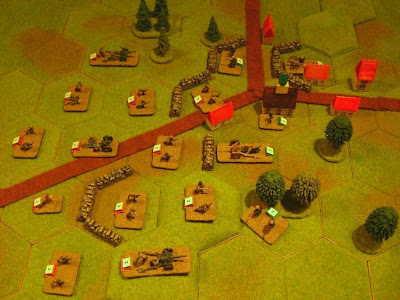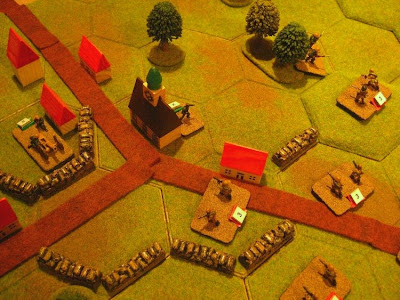This play-test was played solo so that I could try out the various adaptations I have made to the TABLE TOP BATTLES wargames rules so that they can be used for mid-20th century warfare with Hexon II hexes. I chose a World War II Eastern Front setting as I already had suitably based figures and vehicles.
Scenario
Elements of a Luftwaffe Feld Divisione had been given the task of defending a small town and road junction that lay between a range of small hills. The junction was important because it served as a major supply route for the German units in the area. The 3 infantry units of the Luftwaffe Feld Divisione were rated as ‘Conscript’ and had a points value of 2, as did the German anti-tank and mountain artillery units. The General commanding the Luftwaffe troops was rated as ‘Average’ and also had a points value of 2.
A Russian offensive had broken through the German front-line, and the objective for part of the advancing Russian forces was the town and road junction. The troops allocated for the task included 9 infantry units (all rated as ‘Regular’ and with a points value of 3), 2 field artillery units and 2 anti-tank artillery units (each with a points value of 2) and an ‘Average’ General (also with a points value of 2). The Russians also had 2 tank units equipped with T34 medium tanks (with a points value of 3) and each carried a ‘Regular’ infantry unit (with a points value of 3). These were to be used to exploit the capture of the town and road junction.
Turn 1
The Russians had the initiative during this turn.
The Russians advanced towards the main German positions. The advance is led by a line of 6 infantry units supported by the field artillery units in the centre and with the flanks guarded by the anti-tank artillery units.
The Germans did not move any of their units. The leading Russian infantry units on the right opened fire on the nearest German unit. This forced the German unit to withdraw, where it then came under fire from the 2 Russian field artillery units. Their fire was very effective and forced the German unit to withdraw even further away from the main German line of defence.
The leading Russian infantry units on the right opened fire on the nearest German unit. This forced the German unit to withdraw, where it then came under fire from the 2 Russian field artillery units. Their fire was very effective and forced the German unit to withdraw even further away from the main German line of defence.
The German mountain artillery concentrated its fire on the leading Russian infantry unit on the left and destroyed it.
The Germans had the initiative during this turn.
Before the Russians could occupy the empty front-line defences, the German infantry unit occupying the centre of the German defences moved into them. They were – in turn – replaced by the German infantry unit that had been forced to withdraw.
The Russians continued their advance on the German positions and brought forward a further 3 infantry units to support the attack.
The Russian replied with fire from every unit within range of the German unit occupying the foremost German defensive position. This concentration of fire was – for the most part – ineffective but it did manage to force the German unit to withdraw onto the hill behind its original position.
The Russians had the initiative during this turn.
Seizing the opportunity to close with the Germans, all the Russian troops advanced as far forward as was possible.
In response the Germans did not move and prepared to fight to the death.
In reply the Germans were unable to inflict any serious casualties on the Russians, who were now poised to enter the town.
The Russians had the initiative during this turn.
The inexorable Russian advance continued.
All the Germans could do was to move the infantry unit that had previously withdrawn forward into a wood to the right of the town.
In response the German infantry unit in the wood engaged the Russian infantry unit that was occupying the nearby hill whilst the German mountain artillery unit fired over open sights at the advancing Russians. Unfortunately luck was not with the Germans, whose fire had no effect.
The Germans had the initiative during this turn.
Realising that they were about to be overwhelmed, the German General withdrew his last remaining infantry unit from the wood and into the town in the hope that this would delay the inevitable Russian victory.
The Russian General’s response was predictable – he ordered a full-out advance with the intention of closing on the enemy and destroying them.
The Russian response was swift and terrible, and no German units survived the combined gunfire of the Russian units that were within range.
Once the town and road junction were captured the tank units and their associated infantry units advanced along the road to exploit the breach in the German defences.
The adaptations to the rules seemed to work quite. The play-test took just over two hours including time to do the write-up, and indicated that with a few further adaptations and modifications – possibly to give elite troops an even greater effect and poor quality troops a lesser effect in firefights and Hand-to-Hand combat – it is quite easy use the TABLE TOP BATTLES wargames rules to refight mid-20th century battles on Hexon II hexes.
Scenario
Elements of a Luftwaffe Feld Divisione had been given the task of defending a small town and road junction that lay between a range of small hills. The junction was important because it served as a major supply route for the German units in the area. The 3 infantry units of the Luftwaffe Feld Divisione were rated as ‘Conscript’ and had a points value of 2, as did the German anti-tank and mountain artillery units. The General commanding the Luftwaffe troops was rated as ‘Average’ and also had a points value of 2.
A Russian offensive had broken through the German front-line, and the objective for part of the advancing Russian forces was the town and road junction. The troops allocated for the task included 9 infantry units (all rated as ‘Regular’ and with a points value of 3), 2 field artillery units and 2 anti-tank artillery units (each with a points value of 2) and an ‘Average’ General (also with a points value of 2). The Russians also had 2 tank units equipped with T34 medium tanks (with a points value of 3) and each carried a ‘Regular’ infantry unit (with a points value of 3). These were to be used to exploit the capture of the town and road junction.
Turn 1
The Russians had the initiative during this turn.
The Russians advanced towards the main German positions. The advance is led by a line of 6 infantry units supported by the field artillery units in the centre and with the flanks guarded by the anti-tank artillery units.
The Germans did not move any of their units.
 The leading Russian infantry units on the right opened fire on the nearest German unit. This forced the German unit to withdraw, where it then came under fire from the 2 Russian field artillery units. Their fire was very effective and forced the German unit to withdraw even further away from the main German line of defence.
The leading Russian infantry units on the right opened fire on the nearest German unit. This forced the German unit to withdraw, where it then came under fire from the 2 Russian field artillery units. Their fire was very effective and forced the German unit to withdraw even further away from the main German line of defence.The German mountain artillery concentrated its fire on the leading Russian infantry unit on the left and destroyed it.
The Germans had the initiative during this turn.
Before the Russians could occupy the empty front-line defences, the German infantry unit occupying the centre of the German defences moved into them. They were – in turn – replaced by the German infantry unit that had been forced to withdraw.
The Russians continued their advance on the German positions and brought forward a further 3 infantry units to support the attack.
The Russian replied with fire from every unit within range of the German unit occupying the foremost German defensive position. This concentration of fire was – for the most part – ineffective but it did manage to force the German unit to withdraw onto the hill behind its original position.
The Russians had the initiative during this turn.
Seizing the opportunity to close with the Germans, all the Russian troops advanced as far forward as was possible.
In response the Germans did not move and prepared to fight to the death.
In reply the Germans were unable to inflict any serious casualties on the Russians, who were now poised to enter the town.
The Russians had the initiative during this turn.
The inexorable Russian advance continued.
All the Germans could do was to move the infantry unit that had previously withdrawn forward into a wood to the right of the town.
In response the German infantry unit in the wood engaged the Russian infantry unit that was occupying the nearby hill whilst the German mountain artillery unit fired over open sights at the advancing Russians. Unfortunately luck was not with the Germans, whose fire had no effect.
The Germans had the initiative during this turn.
Realising that they were about to be overwhelmed, the German General withdrew his last remaining infantry unit from the wood and into the town in the hope that this would delay the inevitable Russian victory.
The Russian General’s response was predictable – he ordered a full-out advance with the intention of closing on the enemy and destroying them.
The Russian response was swift and terrible, and no German units survived the combined gunfire of the Russian units that were within range.
Once the town and road junction were captured the tank units and their associated infantry units advanced along the road to exploit the breach in the German defences.
The adaptations to the rules seemed to work quite. The play-test took just over two hours including time to do the write-up, and indicated that with a few further adaptations and modifications – possibly to give elite troops an even greater effect and poor quality troops a lesser effect in firefights and Hand-to-Hand combat – it is quite easy use the TABLE TOP BATTLES wargames rules to refight mid-20th century battles on Hexon II hexes.


































.jpeg)










Nice game Bob, thanks for the pics.
ReplyDelete--Dave
My pleasure - both to play the game and to share my experience of it with others.
ReplyDelete